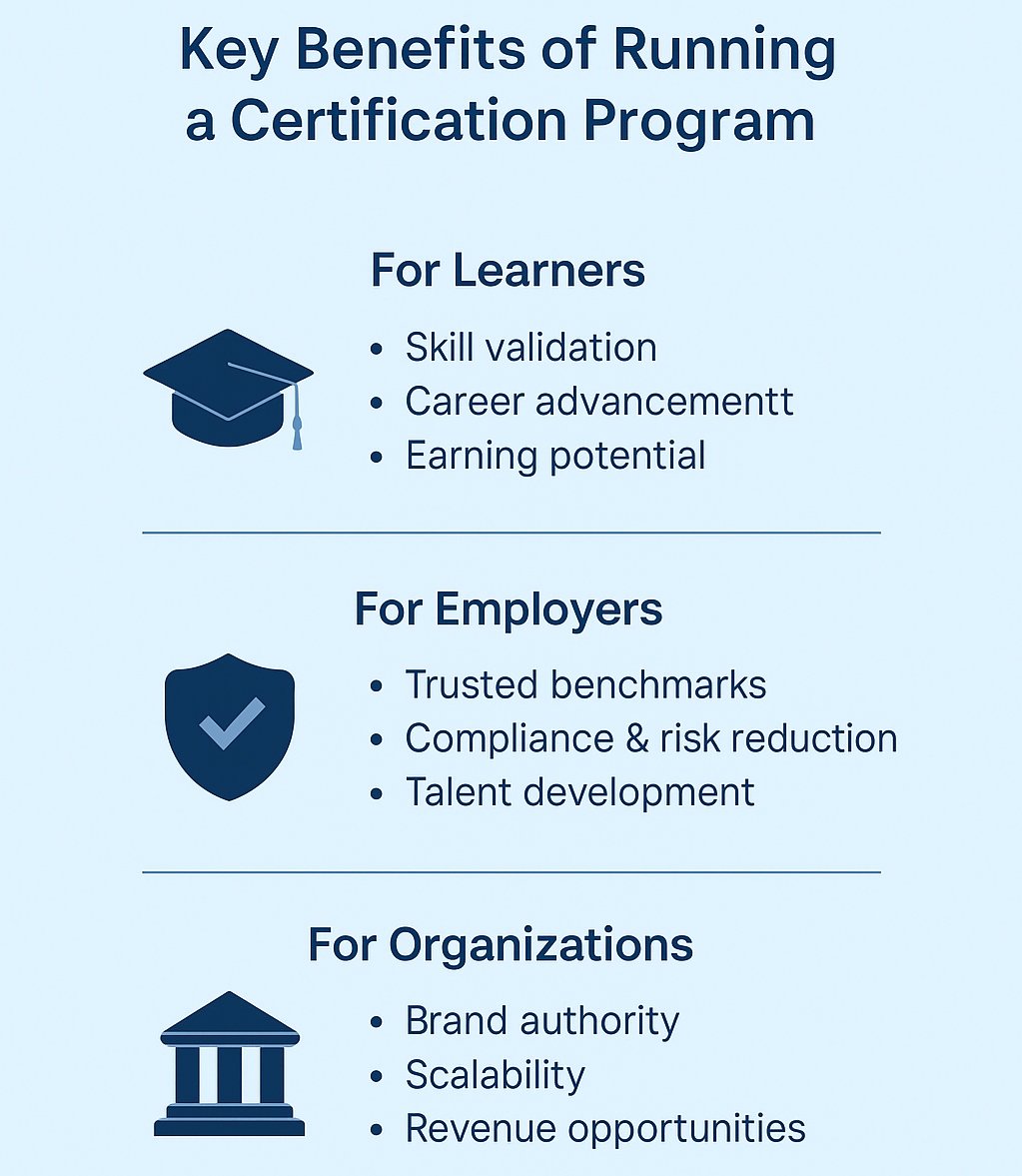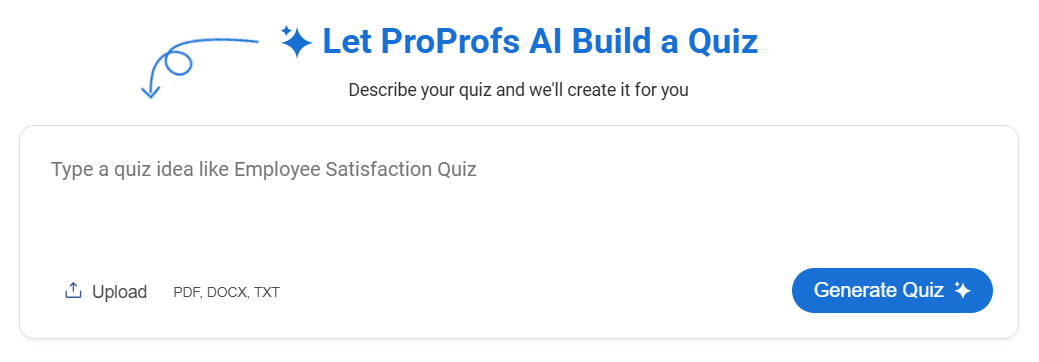As an instructional designer, I’ve been challenged many times on how to create certification programs that don’t just exist, but actually matter.
The market is crowded with credentials, yet most fail to move the needle because they don’t solve a real problem for learners or employers. They look official, but they don’t influence hiring decisions or prove skills in practice.
The real opportunity lies in building certifications that function like products: they meet a market demand, they differentiate from competitors, and they deliver measurable value. That means designing assessments that employers trust, setting renewal policies that keep credentials current, and marketing the program so it gains recognition beyond the training room.
In this guide, I’ll share the framework I use to design certification programs with staying power — ones that learners pursue, employers respect, and organizations can grow into a long-term asset.
Let’s start by laying some groundwork.
What Is a Certification Program (and Why It Matters)?
When I design learning programs, I always remind stakeholders that not every certificate is a certification. The distinction matters.
A certificate usually means someone has completed a course. It signals participation, not necessarily competence.
A certification, on the other hand, is different. It’s an earned credential that verifies a person can actually perform to a defined standard, usually through a quiz or assessment. Certifications often carry weight in industries because they’re tied to professional credibility, compliance requirements, or employer expectations.
Watch: How to Create a Quiz for Online Certification
Certification programs can take many forms:
- Internal certifications validate skills within an organization (e.g., onboarding or compliance training).
- External certifications are industry-facing and recognized by employers or associations.
- Educational certifications are offered by schools or training providers as proof of mastery in a subject.
A well-designed certification isn’t just a document. It’s a structured system for measuring, validating, and signaling expertise.
Key Benefits of Running a Certification Program

When I design a certification program, I don’t start with the certificate — I start with the value it needs to deliver. A well-built program creates benefits for three groups: learners, employers, and the organization offering it.
For Learners
- Skill validation: Certifications prove competence, not just attendance.
- Career advancement: A recognized credential can tip the balance in promotions or job applications.
- Earning potential: Research shows certified professionals often command higher salaries.
For Employers
- Trusted benchmarks: Certifications reassure hiring managers that candidates meet a consistent standard.
- Compliance and risk reduction: In regulated industries, certifications document that employees meet legal or safety requirements.
- Talent development: Internal certifications give employers a structured way to grow and retain staff.
For Organizations
- Brand authority: A respected certification builds thought leadership and market credibility.
- Scalability: Online programs standardize training and assessment at scale.
- Revenue opportunities: Many organizations monetize certifications through paid courses or exams.
Case in point: Life Winks LLC, a childhood innovation and sustainability center, streamlined its licensing process by certifying people through online assessments. Automated certificates not only saved time but also ensured consistency, showing how certification programs can add value operationally while reinforcing credibility.
Watch: How Life Winks LLC Assessed & Certified Their Clients
The true impact of a certification program shows up where these benefits overlap. Learners walk away with recognized credentials that advance their careers. Employers gain reliable proof of skills they can trust in hiring and development. And organizations build authority, improve efficiency, and meet business goals — all at the same time.
Common Pitfalls to Avoid
Most certification programs fail not because of a lack of effort, but because of avoidable mistakes. The patterns are surprisingly consistent:
1. “Paper Certifications” With No Recognition
A certificate that isn’t backed by employers or industry bodies quickly loses value. Learners see through it, and employers dismiss it.
2. Weak Assessments
If the exam is too easy, too theoretical, or poorly proctored, it doesn’t measure real competence. This undermines trust in the credential.
3. Underestimating Resources
Developing a rigorous program takes more than uploading a quiz. It requires subject matter experts, assessment design expertise, and ongoing updates — sometimes more time and budget than teams expect.
4. Poor Technology Choices
Clunky platforms frustrate learners and administrators alike. Long navigation paths, weak reporting, or limited customization erode the learner experience and the program’s credibility.
5. No Marketing Or Renewal Strategy
Even a strong program won’t succeed if nobody knows it exists. Likewise, certifications without renewal policies quickly become outdated, weakening their perceived value.
Avoiding these pitfalls is half the battle. The other half is designing a program around clear learner outcomes, industry credibility, and sustainable delivery.
How to Create Certification Programs: Step-by-Step Guide
A certification program isn’t just another course with a test tacked on. It’s a structured system for validating skills, building credibility, and delivering measurable value to both learners and employers. Here’s how to design one that lasts:
Step 1: Identify Your Target Audience and Market Need
Before creating a single lesson, clarify who the program is for and why it matters. Certification programs fail when they exist in a vacuum, with no clear demand.
Why It Matters: A recognized need ensures learners see ROI and employers respect the credential.
How to Do It:
- Interview employers to find skills gaps they struggle to hire for.
- Scan industry reports and competitor certifications — where are the overlaps, and what’s missing?
- Survey your audience to test interest and willingness to invest in certification.
Step 2: Define Goals and Outcomes
Once the need is validated, write SMART goals — specific, measurable, achievable, relevant, and time-bound.
Why It Matters: Clear outcomes keep the curriculum focused and the exam credible.
How to Do It:
- Translate market needs into learning outcomes: “By the end of this program, learners will be able to …”
- Separate learning goals (knowledge, skills) from credentialing goals (compliance, recognition).
- Decide how you’ll measure success: pass rates, employer adoption, or revenue targets.
Example: “Certified Data Analysts will be able to build dashboards in Power BI that meet business requirements.”
Step 3: Design the Curriculum With Experts
Bring in subject matter experts (SMEs) early. As an instructional designer, my role is often to structure their expertise into a learning path that aligns with real job tasks.
Why It Matters: Employer recognition depends on the program reflecting actual job performance, not abstract theory.
How to Do It:
- Conduct a job task analysis to define the competencies that must be certified.
- Map each competency to a learning objective and course module.
- Balance formats: self-paced eLearning, instructor-led sessions, or blended learning.

Step 4: Build Rigorous Assessments
Assessment is where certifications prove their worth. Weak exams are why so many online certification programs are dismissed as fluff.
Why It Matters: Without valid, reliable exams, your certification loses credibility fast.
How to Do It:
- Choose assessment types that match skills: scenario-based questions for problem-solving, simulations for technical skills, projects for applied competence.
- Create the assessments using an online test maker.
- Implement anti-cheating measures: randomized question banks, time limits, browser lockdowns, and remote proctoring.
- Use analytics to identify weak items and recalibrate.
Watch: How to Review Assessment Reports
Example: Instead of asking “What is X?” in multiple choice, create a scenario: “You encounter Y situation. Which action would you take?”
Step 5: Choose the Right Platform
Technology is the backbone of delivery. A clunky platform undermines both the learner experience and the program’s reputation.
Why It Matters: Learners judge certification quality by the ease and professionalism of delivery.
How to Do It:
- Look for automation: instant grading, automated certificates, expiry tracking.
- Prioritize integrations with your LMS, HR, or CRM systems.
- Ensure multilingual support and branding options for scalability.
- Check for reporting dashboards, compliance tracking, custom certificate templates, and proctoring support.
Step 6: Pilot and Refine the Program
A pilot phase is where hidden issues surface. Think of it as your insurance policy before launch.
Why It Matters: Feedback from a small group prevents reputational damage at scale.
How to Do It:
- Recruit a diverse test group (different roles, skill levels).
- Gather data on exam pass rates, content clarity, and platform usability.
- Adjust question difficulty, fix confusing instructions, and improve user flow.
Step 7: Launch With a Marketing Strategy
Even the most credible certification programs fail if no one knows about them. Marketing isn’t an afterthought — it’s part of the design.
Why It Matters: Enrollment drives adoption; employer recognition drives credibility.
How to Do It:
- Define learner personas: Are you targeting job seekers, mid-career professionals, or corporate teams?
- Leverage employer endorsements, industry partnerships, and alumni testimonials.
- Use LinkedIn campaigns, webinars, and thought leadership content to position the certification as valuable.
Step 8: Maintain and Update the Program
A certification program is never “done.” Ongoing relevance is what separates respected credentials from “paper certifications.”
Why It Matters: Industries evolve, regulations shift, and technologies change.
How to Do It:
- Refresh content every 1–2 years based on industry updates.
- Rotate and update exam questions to maintain rigor.
- Set renewal requirements (continuing education, retesting, or recertification).
Example: Healthcare certifications often require renewal every two years to ensure practitioners stay current with safety protocols.
By following these steps, you avoid the trap of building a certification no one values. Instead, you create a structured, credible program that learners trust and employers recognize.
FREE. All Features. FOREVER!
Try our Forever FREE account with all premium features!
Tools and Technology That Simplify Certification
The strength of a certification program depends not only on its design, but also on how smoothly it’s delivered. The right platform can automate time-consuming tasks, secure your assessments, and create a professional learner experience. The wrong one can frustrate both learners and administrators.
What to Look for in a Platform
- Automation: Instant grading, auto-generated certificates, reminder emails, and renewal tracking.
- Assessment Security: Question randomization, time limits, browser lockdowns, and remote proctoring.
- Reporting and Analytics: Dashboards that show pass/fail rates, skill gaps, and compliance status.
- Integrations: Compatibility with LMS, HR, and CRM systems to fit into existing workflows.
- Customization: Branded certificates, multilingual support, and white-labeling for enterprise use.
- AI-Powered Content Creation: The ability to generate quizzes from docs, prompts, videos, or webpages.
Watch: How to Create Custom Certificates With Your Own Logo & Branding
Types of Tools to Consider
- Assessment Software (e.g., ProProfs Quiz Maker) for building secure, auto-graded quizzes with AI, randomizing questions, and issuing certificates automatically.
- Learning Management Systems (LMS) (e.g., ProProfs Training Maker) for hosting courses, combining training with certification, tracking learner progress, and managing compliance at scale.
Why These Tools Matter
Used together, an LMS and assessment software provide the backbone of a certification program: one handles the learning path, while the other ensures valid, secure assessment and credentialing. This combination reduces manual effort, protects credibility, and delivers a professional learner experience.
To make platform selection easier, I’ve created a practical checklist covering the key features to look for in both assessment software and LMSs.
Future of Certification Programs
Certification is evolving quickly. Learners, employers, and industries expect more than static credentials — they want certifications that adapt, integrate, and prove ongoing relevance. Here are some of the shifts shaping the future:
1. AI-Driven Training & Assessments
Artificial intelligence is beginning to power quiz and course generation, adaptive testing, and automated grading. This makes assessments more responsive to learner performance and reduces the manual burden of exam creation.
With an AI quiz maker, you can generate quizzes instantly from a topic, document, or video — turning ideas and materials into certification-ready assessments in minutes.

2. Micro-Credentials and Stackable Pathways
Instead of one large certification, many learners prefer smaller, modular credentials that can be combined into a broader qualification. This flexibility allows professionals to demonstrate progress step by step and build a portfolio of skills.
3. Skills-Based Hiring
Employers are increasingly prioritizing proven skills over degrees. Certifications that align directly with job competencies will carry more weight in recruitment, onboarding, and internal promotions.
4. Digital Badges and Renewals
Static certificates are being replaced by digital badges that can be verified online and shared on platforms like LinkedIn. Renewal cycles ensure that certifications remain relevant, especially in fast-changing industries.
Create a Lasting Certification Program
The hardest part of learning how to create certification programs is making them credible. A certificate only matters if it reflects real skills, is trusted by employers, and stays relevant over time. Programs built on these principles don’t just attract learners — they stand out in a crowded market.
Keeping that credibility requires smart design choices: clear standards, strong assessments, and renewal policies that keep the credential current. The right tools also help by reducing the heavy lifting.
For example, platforms like ProProfs Quiz Maker can issue certificates automatically, manage expirations, and handle recertification reminders — giving you the structure to run a program that learners value and employers respect.
Frequently Asked Questions
How do I make sure my certification program is credible?
Credibility comes from recognition. Involve subject matter experts, align with industry standards, partner with employers or associations, and use secure assessments. Accreditation or third-party validation can further boost trust.
How much does it cost to build a certification program?
Costs vary widely depending on scope. A small internal program might only require software and SME time, while an industry-wide certification could involve psychometric testing, accreditation fees, and marketing. Budget for both development and ongoing maintenance.
What’s the difference between a certificate and a certification program?
A certificate usually proves course completion, while a certification validates demonstrated competence through an exam or assessment. Certifications carry more weight with employers because they signal tested skills, not just participation.
How do I prevent cheating in online certification exams?
Use a mix of strategies: randomized question banks, time limits, browser lockdowns, webcam proctoring, and identity verification. Strong exam security not only protects integrity but also boosts employer confidence in the credential.

 We'd love your feedback!
We'd love your feedback! Thanks for your feedback!
Thanks for your feedback!







